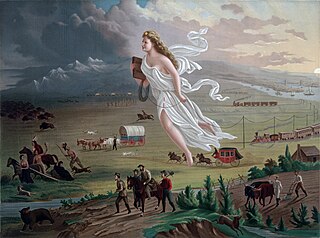
Manifest destiny was a phrase that represented the belief in the 19th-century United States that American settlers were destined to expand westward across North America, and that this belief was both obvious ("manifest") and certain ("destiny"). The belief was rooted in American exceptionalism and Romantic nationalism, implying the inevitable spread of the Republican form of governance. It was one of the earliest expressions of American imperialism in the United States of America.
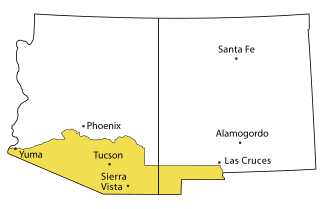
The Gadsden Purchase is a 29,640-square-mile (76,800 km2) region of present-day southern Arizona and southwestern New Mexico that the United States acquired from Mexico by the Treaty of Mesilla, which took effect on June 8, 1854. The purchase included lands south of the Gila River and west of the Rio Grande where the U.S. wanted to build a transcontinental railroad along a deep southern route, which the Southern Pacific Railroad later completed in 1881–1883. The purchase also aimed to resolve other border issues.

The Treaty of Guadalupe Hidalgo officially ended the Mexican–American War (1846–1848). It was signed on 2 February 1848 in the town of Guadalupe Hidalgo.

William Walker was an American physician, lawyer, journalist, and mercenary. In the era of the expansion of the United States, driven by the doctrine of "manifest destiny", Walker organized unauthorized military expeditions into Mexico and Central America with the intention of establishing slaveholding colonies. Such an enterprise was known at the time as "filibustering".

James Gadsden was an American diplomat, soldier and businessman after whom the Gadsden Purchase is named, pertaining to land which the United States bought from Mexico, and which became the southern portions of Arizona and New Mexico. James Gadsden served as Adjutant General of the U.S. Army from August 13, 1821 – March 22, 1822. Between 1853 and 1856, he served as U.S. Minister to Mexico. He was known commonly as General Gadsden, although he never had a rank above colonel.

The Knights of the Golden Circle (KGC) was a secret society founded in 1854 by American George W. L. Bickley, the objective of which was to create a new country, known as the Golden Circle, where slavery would be legal. The country would have been centered in Havana and would have consisted of the Southern United States and a "golden circle" of territories in Mexico, Central America, northern parts of South America, and Cuba, Haiti, Dominican Republic, and most other islands in the Caribbean, about 2,400 miles (3,900 km) in diameter.
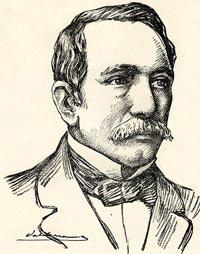
Narciso López de Urriola was a Venezuelan-born adventurer and Spanish Army general who is best known for his expeditions aimed at liberating Cuba from Spanish rule in the 1850s. His troops carried a flag that López had designed, which later became the flag of Cuba. Following his final failed attempt he was captured and garroted in Havana.
A filibuster, also known as a freebooter, is someone who engages in an unauthorized military expedition into a foreign country or territory to foster or support a political revolution or secession. The term is usually applied to United States citizens who incited insurrections across Latin America, particularly in the mid-19th century, usually with the goal of establishing an American-loyal regime that could later be annexed into, or serve the interests of, the United States. Probably the most notable example is the Filibuster War initiated by William Walker in Nicaragua in the 1850s.
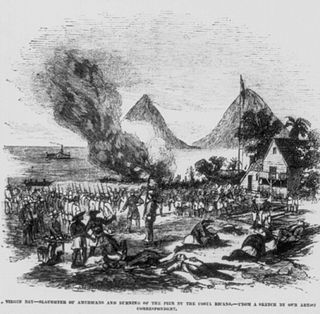
The Filibuster War or Walker affair was a military conflict between filibustering multinational troops stationed in Nicaragua and a coalition of Central American armies. An American mercenary, William Walker, invaded Nicaragua in 1855 with a small private army. He seized control of the country by 1856, but was ousted the following year.
General José María Yáñez Carrillo was a Mexican soldier who fought in the Mexican War of Independence. He also served in the Mexican-American war and the war against the French attempt to create an empire in Mexico.
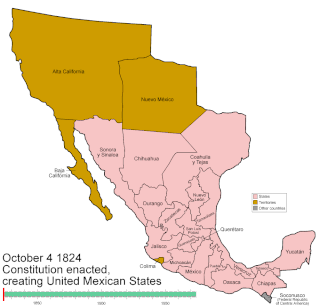
Mexico has experienced many changes in territorial organization during its history as an independent state. The territorial boundaries of Mexico were affected by presidential and imperial decrees. One such decree was the Law of Bases for the Convocation of the Constituent Congress to the Constitutive Act of the Mexican Federation, which determined the national land area as the result of integration of the jurisdictions that corresponded to New Spain, the Captaincy General of Yucatán, the Captaincy General of Guatemala and the autonomous Kingdoms of East and West. The decree resulted in the independence from Spain.

Prior to the adoption of its name for a U.S. state, Arizona was traditionally defined as the region south of the Gila River to the present-day Mexican border, and between the Colorado River and the Rio Grande. It encompasses present-day Southern Arizona and the New Mexico Bootheel plus adjacent parts of Southwestern New Mexico. This area was transferred from Mexico to the United States in the Gadsden Purchase of 1853. Mining and ranching were the primary occupations of traditional Arizona's inhabitants, though growing citrus fruits had long been occurring in Tucson.

Charles René Gaston Gustave de Raousset-Boulbon was a French adventurer, filibuster and entrepreneur and, by some accounts a pirate, and a theoretician of colonialism.
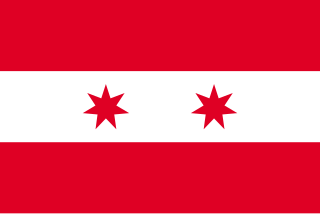
The Republic of Lower California, also known as the Republic of Baja California was a proposed state from 1853 to 1854, after American private military leader William Walker failed to invade Sonora from Arizona. Walker wanted to appropriate Sonora, and his claims had both the support of tycoons and government complacency in the United States.

Henry Lawrence Kinney was an American politician, military officer, and later filibuster known for founding what became the city of Corpus Christi, Texas. Born in Pennsylvania, Kinney moved to Texas in 1838 and settled near present-day Brownsville. He served in both houses of the Texas Legislature. He was killed in a gunfight in Mexico in 1862. Kinney County, Texas is named for him.
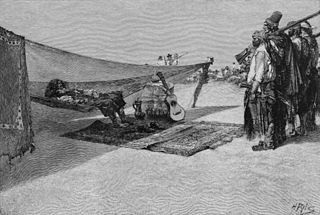
Between 1665 and 1857, Caribbean pirates and filibusters operated in Lake Nicaragua and the surrounding shores. The Spanish city of Granada, located on the lake, was an important trading centre for much of its early history so it was a prime target for pirates such as Welshman Henry Morgan and freebooters like William Walker.

The Crabb Massacre was the culmination of the eight-day Battle of Caborca. It was fought between Mexico and their O'odham allies against irregular forces from the United States in April 1857. Due to the outbreak of the Reform War in Mexico between conservatives and liberals (1858-1860), the rebel Ignacio Pesqueira invited the U.S. politician Henry A. Crabb to colonize the northern frontier region in the state of Sonora. The colonists could help Pesqueira fight in the civil war and against the Apache.
Rancho San Antonio Abad, a land grant in what is now the western part of Tijuana in the Tijuana Municipality of Baja California, Mexico. The name of the rancho derives from Saint Anthony the Abbot.

The William Walker Filibuster Expedition to Baja California and Sonora occurred in the year of 1853, after a failed attempt by Walker himself to invade Sonora from the Arizona border. William Walker sought to appropriate Sonora, and in his claims he had the support of magnates and the complacency of the United States government. In November 1853 he embarked with two hundred men towards La Paz, where he was able to capture the political chief and proclaimed the independence of the Republic of Baja California, a state that never had recognition nor did it exist in the facts, since Walker never had total control of the peninsula or had the support of the population. Rather, he faced resistance from the army and Mexican civilians, among which the group commanded by Antonio Meléndrez stands out. In spite of being folded in Ensenada and suffering the mutiny of his troops from the United States, Walker proclaimed himself president of the Republic of Sonora, which also included Baja California and that, like its successor, did not have existence in fact nor any recognition. In fact, Walker only reached the territory of Sonora in 1854 when pressured by the navy of the United States and Mexico, he had to flee Ensenada. Before the harassment of Meléndrez and the desertion of another part of his troops, Walker and the remnant of his filibuistero army surrendered in San Diego to the American army. Taken to trial, the judge said he was guilty of violating the Neutrality Law signed between Mexico and the United States after the US invasion of Mexico in 1847. However, Walker was acquitted by the jury.

The Flag of Baja California Sur is the flag used by the Mexican state of Baja California Sur. The flag was adopted December 31, 2017. The State Flag consists of a white rectangle with a ratio of four to seven between the width and length; in the center it bears the State Coat of arms, placed in such a way that it occupies three-quarters of the width.

















